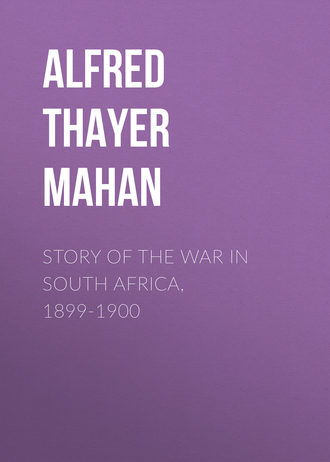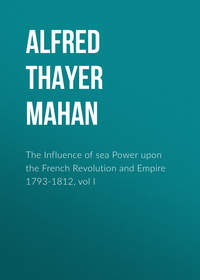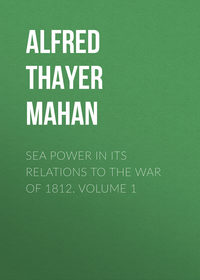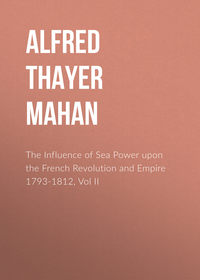 полная версия
полная версияStory of the War in South Africa, 1899-1900
The following afternoon—Saturday, the 21st—a demonstration was made by this force; but it was not pushed home, being confined to a bombardment by two heavy guns—40-pounders—at a range of 6,000 yards. In prevision of such an attempt, Yule had already shifted some of his equipage, and now, finding that the hostile guns outranged his own, he removed the camp two miles to the southward, on high ground. On the 22nd, news being received of the enemy's defeat at Elandslaagte the day before, he endeavoured to cut off the fugitives at Glencoe, but the nearness of the northern Boers compelled him to desist, and finally to resume his last position. Realising from all the conditions that Dundee could not be held, unless reinforced, and that reinforcement was improbable, he decided now to retreat upon Ladysmith.
At 9 P.M. that night the British marched out, taking their transport trains, but necessarily leaving the wounded behind them. The road followed diverges from the railroad to the eastward, crossing the Biggarsberg, and coming out at a place called Beith. There it forks, the right-hand branch trending toward Ladysmith, parallel to the railroad and distant from it eight to ten miles. The march was severe, for the pace was necessarily rapid and sustained, and the roads heavy from recent rains; nor was it without serious risk from the nearness of the enemy, although the battle of Talana Hill had done much to free the eastern flank, and that of Elandslaagte the western. No molestation was experienced.
It is necessary now to narrate the operations of the Ladysmith garrison, which cannot in effect be dissociated from those of its dependant at Dundee.
The demonstrations of the Boers, in various directions, kept Sir George White in doubt as to their immediate intentions until Thursday, the 19th, when Elandslaagte was occupied by the force under General Koch. The same day word was received of the enemy's approach to Dundee. Both movements threatened to isolate the latter. On the 20th a reconnaissance toward Elandslaagte was made by General French, who had arrived the day before from England. Thick weather prevented precise determination of the hostile numbers or position, but the general fact was established. That evening the successful results of the day's action at Dundee became known, and the next morning—Saturday, October 21—the reconnaissance was resumed under better atmospheric conditions. From a cliff between two and three miles from Elandslaagte a clear view of the enemy was obtained, and their fire drawn, which proved that both numerically and in artillery they were superior to the detachment before them. They had expected reinforcements, and those engaged in the ensuing affair were probably nearer 2,000 than to the 1,000 of two days before.
French telegraphed to Ladysmith and received a promise of more troops, the last of which arrived—the infantry by train—about 3 P.M. Meantime the enemy had quitted Elandslaagte for a ridge of rocky hills about a mile and a half south-east of the station—a position characterised as exceptionally strong by Sir George White, who witnessed the affair, but left its management in French's hands. More in detail, the ridge is described as being about 800 feet high, 800 to 1,000 yards long, and in a general sense perpendicular to the railroad; lying, therefore, south-east and north-west. At the latter extremity, nearer the road, are two marked elevations, with a neck between them, in which was the Boers' laager. Of these the westernmost is the higher, but both commanded the rest of the ridge throughout its full extent to the south-east. In front of the ridge the country, of general rolling contour, presents a shallow valley some two or three miles wide. The near side of this to the British, when the latter first advanced, was occupied by a few Boers, but these fell back quickly to their main body. In making their dispositions the Boers occupied in chief force the western elevations, intrenching their artillery on the inner and lower of the two. A thinner firing line was developed thence to the eastward, along the summit of the ridge covering the approach from the front. A flank being usually the weakest part of a line, the natural course for the assailant would be to attack in flank at the lower—eastern—extremity of the ridge, and to advance thence toward the main positions, supported in so doing by a secondary front attack by riflemen and artillery. To impede such an attempt the Boers had set up at intervals barbed wire fences. Through these, and over a broken rocky surface, the attacking column must fight its way, step by step, till the final hills were reached and could be rushed as Talana had been by their countrymen the day before.
The plan above outlined was the one adopted by General French; seven companies of infantry being allotted to the front attack, a regiment and five companies to that upon the flank. A few squadrons of cavalry accompanied the latter movement, as well to protect it when in performance as to profit by any mishap befalling the enemy. The troops formed just below and under cover of the rising ground on the hither side of the valley fronting the hostile line. The fire of the latter was drawn, and the situation of their artillery thus discovered—despite the use of smokeless powder—by the flashes of their guns, which showed the more clearly against the blackness of a big thunder cloud rising behind the Dutch positions, which enabled the British also to see distinctly the bursting of their own shrapnel over the enemy.
The usual artillery duel succeeded at a distance of 4,500 yards—two miles and a half—but from the lateness of the hour, and the amount of work ahead, no time could be lost, so the infantry operation began as quickly as possible. The front attack moved down into the valley, a firing line of three hundred men covering the space of 500 yards from end to end, its remaining companies following at intervals to support it, and to replace those who fell—to "feed" the line, keeping it at full strength.
The first part of this advance was, on account of the distance, resisted chiefly by artillery fire, which, though accurate, was seen to cause there few casualties. At 1,200 yards from the enemy's positions, being there well within rifle range, the line halted, lay down, and opened fire. The smooth surface of the ground gave little natural shelter; what there was was found chiefly behind ant hills, of which there were very many. The musketry fire here undergone was severe, for the only diversion to it continued so far to be the British artillery, the flanking movement not having yet fully developed. Under the undivided attention of the enemy's riflemen, the line worked its way steadily forward, men dropping frequently, to within 800 yards of the summit, where they finally lay down and waited under a constant fall of shot till the bugle should summon them to the storm.
Meantime, during these last 400 yards, the flank attack was beginning. In general, the first ascent was of the rocky, broken character before noted, both here and at Talana; but, the strength of the Boer force being on the other flank, the assailants, while mounting, were covered by the slope and did not come fairly under fire until the top was reached. Then they began to fall rapidly, but a few paces further the ground dipped, and again gave momentary shelter. It was, however, but to take breath for the final rush; if rush it can be called, which meant steady, dogged bearing up against a pitiless rain of projectiles, and forcing one's way forward rock by rock, while companions drop, one by one, on either side. Six hundred yards of such work lay, before the flanking column, interrupted ever and anon by the barbed-wire obstacles, which, however, were themselves often cut down by the intensity of the fire.
Under such conditions the community of action which rests upon formal organisation and method ceases to be effectual. The momentum that endures to the end, and so effects the results of co-operation, finds its energy partly in individual character, partly in the moral fellowship of impulse and of purpose which, once imparted, remains subconscious, perhaps, but ineradicable. The man knows, or rather feels, that if he gets to the end he will find his comrades there; and that if he goes back he will not find them, but his own self-contempt. Such is unanimity, the oneness of will that comes of a common training and of common ideals, bred-in, if not inborn. So this mass of men, independent each, and yet members, each, one of the other, struggled forward, through failing light and drenching rain—for the storm had burst as the ascent began—till half the way was won. Then the bugle sounded "Charge," and the reply came cheerily up from below. The men, in the valley and on the hill, moved forward with the bayonet, still not neglecting cover, but looking now more to speed. Again, as usual, save a few of the more stubborn who were killed at their guns, the defenders did not await the shock but fled down the hills, where the cavalry that had accompanied the flank attack got among them and completed their discomfiture.
The battle at Elandslaagte was distinctly creditable to both sides, but upon the whole gave sounder cause for self-congratulation to the British than to their opponents. The former were numerically superior to the defenders, but not to an extent which countervailed even the natural advantages of the ground, further improved by measures for which time allowed.
Regarded apart from its connection with the campaign as a whole, simply as a combat unrelated to other incidents, the conception and the execution of the attack were admirable; while in the matter of military dynamic energy, to whatever source that shown on the one side or the other may be attributed, the potentiality of the attacking force was demonstrated to be greater than that of the opponent.
Still more was the action at Elandslaagte commendable, when viewed in relation to the general respective conditions of the Boers and the British in Natal at that time.
Duly to appreciate the merits and the results of these two successive days of fighting, at Talana and at Elandslaagte, it must be remembered that the British in a general sense, and at Dundee locally as well, were upon the defensive, and that the Boer movements were each a part of one general plan directed, and most properly, to overwhelm and destroy the detachments—Dundee and Ladysmith—in detail; they together being rightly considered one fraction of the enemy's whole force, present or hurrying over sea. So regarded, the vigour with which the British took the initiative, assumed the offensive, themselves in turn attacking in detail, and severely punishing, the separate factors of the enemy's combination, is worthy of great praise. Sir Penn Symons is perhaps entitled to the greater meed because to him fell, with the greater burden, the greater opportunity, to which he proved not unequal.
Such men were worthy of the steady forward gallantry shown by officers and men. Both leaders and led easily carry off the palm from the more phlegmatic opponents, who failed to sweep them away. The result was to save Ladysmith, or rather—what was most really important—to save the organized force that was there shut in. The brilliant antecedent campaign, the offensive right and left strokes, the prompt and timely resolve of Yule to retreat just as he did, and the consequent concentration, utterly frustrated the Boers' combinations, and shattered antecedently their expectations of subduing the British by the cheaper method of exhaustion. The failure was not only signal, but in the end discreditable; for while success is no sure proof of merit, nor its opposite of indesert, the wide miscalculation of the ultimate result, which kept the Boers so long inactive before Ladysmith, and saved Natal, while reinforcements were well known all the while to be hasting across the sea, is entitled to scant respect from any indications in its favour. The faulty execution of the original plan, which enabled the enemy to concentrate and to accumulate adequate means of resistance, and the subsequent underestimate of the endurance of the garrison, bear the same mark. In issuing their ultimatum, in opening the campaign, in combining against Dundee, and finally in investing Ladysmith, the Boers exceeded decisively that five minutes of delay upon which, to use Nelson's words, turns victory or defeat; and the loss of time, as yet only serious, through the procrastinations of the siege became irremediable.
It is noticeable that the returns of casualties at Elandslaagte do not perfectly bear out extreme conclusions as to the fatal preponderance of the defence over the offence in modern warfare. As reported soon after the action, the British lost in killed, 55; in wounded, 199. Of the Boers, 65 dead were found on the ground; others, estimated—guessed is perhaps more correct—at 50, were killed in pursuit by the cavalry. Their wounded is not stated, but there were many among the three hundred prisoners taken. It is true, certainly, that in this affair not only was the British attack well combined, but their superiority in numbers was considerable. Still, after all deductions, the greater loss of the defendants casts doubt, either upon their marksmanship or upon the prevalent theory that the effects of modern weapons are revolutionary. As a historical fact, a front attack upon intrenched men, even irregulars, has been a desperate business as far back, at least, as Bunker Hill and Fort Moultrie.
Twenty-four hours after Elandslaagte, at 9 P.M., Sunday, October 22, Yule's men started on their march of sixty miles, of mountain climb and over rain-drenched roads, to Ladysmith. Their own work at Talana Hill had secured the left flank of their retreat, by the demoralization of Meyer's force; to protect their right, the increasing numbers and threatening movements of the enemy west of the railroad impelled Sir George White to further action. On the 24th he moved out a strong force, which discovered the enemy at Rietfontein, seven miles from Ladysmith, on a ridge west of, and parallel to, the Glencoe road; their artillery intrenched in the centre, and supported by infantry upon commanding elevations at either end. The British drew up on a parallel ridge, to the eastward, and an action ensued, confined mainly to artillery at 3,000 yards. In the end the Boers, chiefly a body of Free State men, evacuated their positions about 2 P.M. and retired to the westward. Pursuit was not attempted. The security and junction of Yule's detachment was the prime immediate necessity, and it was by this fully apparent that the time was come when offensive returns, on the part of the greatly outnumbered British, must be limited to those needed to insure necessary delay before final inevitable interception and investment. It was no occasion for displays of military fancy sparring.
Shortly after noon of Thursday, October 26, Yule's column marched into Ladysmith—"done up," telegraphed White, "but in good spirits and only need rest." The lamented Steevens, with his graphic pen, has described for us the pride, pomp and circumstance of the return of the men who had stormed Talana Hill, and had still before them the grim protracted realities of Ladysmith.
"Before next morning was gray in came the 1st Rifles. They plashed uphill to their blue-roofed huts on the south-west side of the town. By the time the sun was up they were fed by their sister battalion, the 2nd, and had begun to unwind their putties. But what a sight! Their putties were not soaked and not caked; say, rather, that there may have been a core of puttie inside, but that the men's legs were imbedded in a serpentine cast of clay. As for their boots, you could only infer them from the huge balls of stratified mud they bore round their feet. Red mud, yellow mud, black mud, brown mud—they lifted their feet toilsomely; they were land plummets that had sucked up specimens of all the heavy, sticky soils for fifteen miles. Officers and men alike bristled stiff with a week's beard. Rents in their khaki showed white skin; from their grimed hands and heads you might have judged them half red men, half soot-black. Eyelids hung fat and heavy over hollow cheeks and pointed cheekbones. Only the eye remained—the sky-blue, steel-keen, hard, clear, unconquerable English eye—to tell that thirty-two miles without rest, four days without a square meal, six nights—for many—without a stretch of sleep, still found them soldiers at the end.
"That was the beginning of them; but they were not all in till the middle of the afternoon—which made thirty-six hours on their legs. The Irish Fusiliers tramped in at lunch-time—going a bit short some of them, nearly all a trifle stiff on the feet—but solid, square and sturdy from the knees upward. They straightened up to the cheers that met them, and stepped out on scorching feet as if they were ready to go into action again on the instant. After them came the guns—not the sleek creatures of Laffan's Plain, rough with earth and spinning mud from their wheels, but war-worn and fresh from slaughter; you might imagine their damp muzzles were dripping blood. You could count the horses' ribs; they looked as if you could break them in half before the quarters. But they, too, knew they were being cheered; they threw their ears up and flung all the weight left them into the traces.
"Through fire, water and earth, the Dundee column had come home again."3
The undeniable error of placing an advanced detachment in Dundee had thus been redeemed; at much material cost, it may be granted, but the moral gain probably exceeded, and the gallant author of the mistake paid for his error with his life. General Symons died in Dundee on the day his column came in touch with the Ladysmith force.
In the ensuing week the Boers in largely superior numbers closed rapidly down upon the now concentrated British, who on their part strained every nerve to accumulate strength and resources, and to secure time, by imposing caution and delay upon the enemy.
It was in an attempt of this kind that the disaster at Nicholson's Nek was incurred. The enemy had appeared in great numerical strength upon the hills, from three to five miles north of the town, and thence round to the eastward, over a line of seven or eight miles. A reconnaissance in force was planned for Monday, October 30, and in support of it, to secure the British left flank, a detachment of a dozen companies of infantry with a mountain battery started at 11 P.M., Sunday, to march nearly due north, up the bed of a stream called Bell's Spruit, to occupy the elevation known as Nicholson's Nek. Advance along the broken, rock-strewn, and unfamiliar watercourse was necessarily slow, but was unmolested until about two hours before daybreak, when some boulders were rolled down from a neighbouring height and fell among the mules of the battery, which was in the middle of the column, preceded and followed by infantry. The terrified creatures broke from their keepers, turned, and dashed in the darkness through the rear of the division, where several shots were fired into them by the startled soldiers, unable to see the character of the rush they felt. Confusion necessarily ensued, and the panic spread to the other ammunition animals, which stampeded. Order was with difficulty restored, and the detachment, thus arrested, at daybreak found itself still two miles short of its destination. It was not thought expedient to press on; and refuge, rather than position, was sought upon a hill near by, which looked defensible, but upon climbing was found to be commanded from several quarters. These were soon occupied by the Boers, and after a resistance protracted to about 3 P.M., the detachment was compelled to surrender. Something over a thousand men were thus lost to the besieged, who could ill afford it. The missing—mostly prisoners—amounted to 843. On the field 52 were found dead, and 150 wounded were brought back to Ladysmith. Less than 100 escaped.
The rest of the British movement was successfully carried out, the enemy retiring before them; but although all the troops were out, except those absolutely needed for garrisoning the works, the enemy's field bases—"laagers"—could not be reached. Their numbers and dispositions so far made were observed; but the approaching powerlessness of the British for decisive offensive action was also shown. Upon returning to camp at 2 P.M., it was happily found that a naval brigade from the cruiser "Powerful," lying at Durban, had reached Ladysmith with long range and heavy guns. These were quickly got into position and soon silenced a Boer 40-pounder, which at daybreak had opened fire on the town from a hill between two and three miles to the northward. A few hours later news came in of the reverse at Nicholson's Nek.
The naval guns arrived in the nick of time, the very day that the enemy got their first heavy piece at work, and but three days before all communication with outside was intercepted. The closeness of the shave emphasizes the military value of unremitting activity in doing, and unremitting energy in retarding an opponent. At one end of the line Talana Hill, Elandslaagte, Rietfontein; at the other, 200 miles away, a naval division rushing guns ashore and to the railroad. The result, a siege artillery opportunely mounted to keep the adversary at distance.
"The enemy's guns," telegraphed Sir George White, October 30, "range further than our field guns. I have now some naval guns, which have temporarily silenced, and I hope will permanently dominate, the enemy's best guns, with which he has been bombarding the town at a distance of over 6,000 yards." "Our forces were seriously outnumbered and our guns outranged" (yesterday), wrote a correspondent in Ladysmith, "until the arrival of the naval brigade, who rendered excellent service." "The prompt assistance rendered by the Navy 190 miles inland has added immensely to the defensive strength of the position, which now depends upon keeping down the enemy's artillery fire. If the siege guns of the Boers can be controlled, the rifle fire of a stout-hearted force ought to render a successful assault impossible."
The naval guns were six—two 4.7 inch, and four long 12-pounders. They were mounted on carriages hastily extemporised for the emergency by Captain Percy Scott, of the Royal Navy, and, as they outranged the army field guns by full 2,000 yards, they extended by at least double that distance the diameter of the circle of investment imposed upon the enemy.
On the 2nd of November telegraphic communication between Ladysmith and the outer world was broken, and the same day railroad communication was intercepted; the last train out carrying General French to take a cavalry command at Cape Town. The brief, exciting, and brilliant prelude to the war was concluded, and a great and controlling centre of national and military interest had been established by the isolation of some 13,000 British in the midst of foes whose numbers are not even yet accurately known, but of whose great superiority in that respect there can be no doubt. For a hundred and eighteen weary days the blockade lasted, until, on February 28, 1900, the advance of the relieving force entered the place.
Almost simultaneously with the beginning of the investment, on the 31st of October, General Sir Redvers Buller arrived from England at Cape Town to take chief command of the British forces in South Africa. The second period of the war now opened, before recounting which it will be necessary to summarize the general situation at date, as constituted by many preliminary occurrences in different, and even remote, quarters of the world. Up to the present, success had seemed to lie with the Boers, but the appearance was only superficial. Their plan had been well designed, but in execution it had failed; and while the failure is to be laid in part to a certain tardiness and lack of synchronism in their own movements, it was due yet more to the well-judged, energetic, and brilliantly executed movements of Sir George White and Sir Penn Symons, which utilised and completed the dislocation in the enemy's action, and so insured the time necessary for organising defence upon an adequately competent scale.
"Sir George White's force," wrote Spencer Wilkinson, on the 18th October, "is the centre of gravity of the situation. If the Boers cannot defeat it their case is hopeless; if they can crush it they may have hopes of ultimate success."4 The summary was true then, and is now. In the preliminary trial of skill and strength the Boers had been worsted.
Note.—The effective British force shut up in Ladysmith on November 2 was 13,496, besides which there were 249 sick and wounded; total, 13,745. The Boer force in Natal is not accurately known, but is roughly reckoned at double the British; say 30,000. This estimate is probable, both from the extent of their operations, and because they ought to have had at least so many. It would be more to their discredit to have had fewer than to fail with more. The non-military element in Ladysmith raised the number of the besieged to about 21,000.











